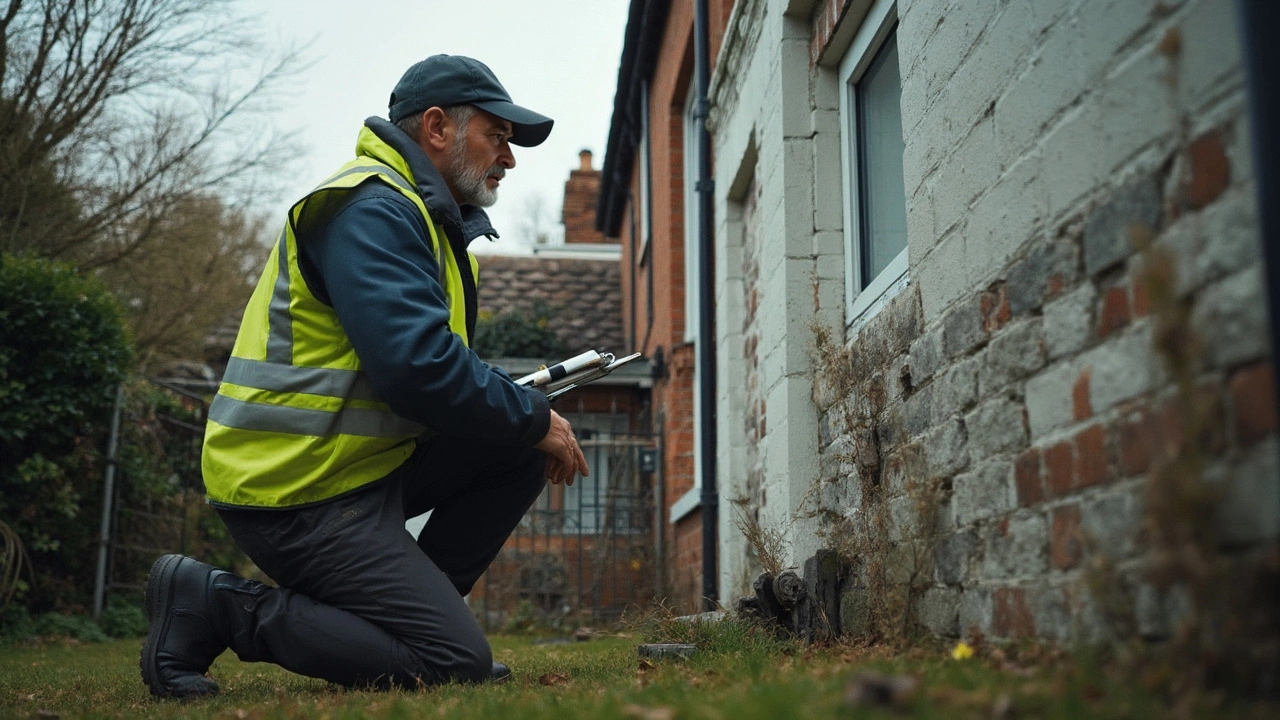Picture this: you walk into a house that’s got almost everything you’ve been looking for, but the inspector finds cracks in the basement or doors that won’t shut right. Foundation problems are scary, no doubt. So why do some buyers still go for these homes? Simple—because most issues aren’t the end of the world, but some can be total dealbreakers if you’re not paying close attention.
First thing you should know: not all foundation cracks are the same. Tiny hairline cracks? Normal in most older homes. Big, jagged cracks wider than a pencil? Time to worry. Houses settle over time, but movement that keeps getting worse is when you should start asking a lot more questions. What you don’t want is to buy a house only to find out a year later the repair bill is the size of a small mortgage.
- What Foundation Problems Really Mean
- How Much Risk Are You Taking?
- Repair Costs and Negotiating Power
- Should You Walk Away or Take the Leap?
What Foundation Problems Really Mean
People throw the term “foundation problems” around a lot, but what are you really looking at? In short, it includes anything that messes with the stability or level of your house—cracks, sinking, bulging walls, sticking doors or windows, or even floors that feel sloped under your feet. The scary part is, not every issue means the place is about to fall over… but some signal big trouble if you ignore them.
The most common culprit is usually bad drainage or water piling up around the foundation. That means rainwater or sprinkler runoff doesn’t get carried away, so it seeps in, causing the soil underneath the home to shift. And if you live somewhere with lots of clay in the dirt (think places like Texas or Oklahoma), you’re at higher risk for foundation repair nightmares because clay swells and shrinks with the weather.
- Horizontal cracks in basement walls: These are widely seen as a red flag. Could point to major soil pressure and a weakening structure.
- Sticking doors/windows: Sometimes it’s just humidity, but in a house with foundation issues, the frame has shifted so things won’t close right.
- Uneven floors: Roll a marble and watch it take off. That usually means something underneath is sinking, not just a sloppy floor job.
- Bulging or bowing walls: The wall itself is bending in or out. That’s more than just an eyesore, it can be a sign the wall is losing its strength.
To get a clearer picture, here’s what different foundation problems typically mean and how often they pop up:
| Problem Type | Common Cause | Is It Serious? |
|---|---|---|
| Small vertical cracks | Normal settling | No, usually cosmetic |
| Large jagged cracks | Soil movement, water, or roots | Yes, get checked by a pro |
| Doors/windows stuck | Foundation shifting | Could be serious, needs a closer look |
| Uneven floors | Foundation sinking or rising | Usually serious |
It’s easy to brush off some cracks as "character," but if you’re thinking about buying a house with foundation problems, you need to know exactly what you’re dealing with. Some fixes are pretty cheap and fast. Others can run $10,000 or more. That’s why being able to spot what's minor and what’s a major problem is key before you even start thinking about making an offer.
How Much Risk Are You Taking?
Buying a house with foundation problems isn’t like buying a place with an ugly paint color—you’re dealing with the stuff that holds the whole house up. Some foundation issues are basically cosmetic, but others spell big trouble. If you’re so-so about taking risks, you’ve got some thinking to do here.
Let’s break it down. Sometimes, all the house needs is fixing a crack in the drywall or filling in a small gap in the concrete. Those are usually cheap and not a huge deal. But if you see things like sloping floors, windows that stick, or doors that never seem to close right, those could mean more serious movement underneath. That’s the kind of problem that could affect everything else—plumbing, walls, flooring, you name it.
Here are a few things that really crank up the risk when buying a home with foundation damage:
- Visible cracks wider than 1/4 inch in walls or floors
- Water pooling around the exterior foundation
- Horizontal or stair-step cracks in brick or block
- Moldy smell or visible water in the basement or crawlspace
- Evidence of previous failed repairs
Most lenders are wary of giving mortgages on houses with unresolved foundation repair needs. You could end up needing a hefty down payment or special loan just to move forward. And don’t expect homeowners insurance to cover cracking or sinking—it’s usually excluded unless damage is sudden, like from an earthquake or burst pipe.
Want some real numbers? One national survey found around 60% of homes in the US have some sort of foundation settlement—most of these are harmless. The serious ones, though, can hurt resale value by up to 20%. That’s a chunk of change considering today’s home prices.
| Issue Severity | Repair Cost Range | Resale Value Impact |
|---|---|---|
| Minor (cosmetic) | $500 - $2,000 | Negligible |
| Moderate (one area) | $4,000 - $10,000 | Up to 10% |
| Major (multiple areas) | $15,000+ | 10-20% or more |
If you’re buying with plans to flip, rent out, or just want a headache-free place to live, weigh these risks against your budget and your nerves. Some buyers get a great deal, but it helps if you go in with eyes wide open.

Repair Costs and Negotiating Power
Let’s talk numbers, because buying a house with foundation problems isn’t just about rolling the dice. Foundation repair costs swing big—from a quick patch for less than $1,000, to full stabilization that can hit $25,000 or more. Most jobs land somewhere in the $4,000 to $12,000 range. These are just averages—some jobs get way pricier if there’s water damage, bowing walls, or the need to jack up half the house.
Here’s a quick look at what different foundation issues can set you back:
| Problem Type | Estimated Cost (USD) |
|---|---|
| Small crack repair | $500 - $1,500 |
| Major crack/bowing wall | $3,000 - $10,000 |
| Full house stabilization/pilings | $12,000 - $25,000+ |
| Waterproofing | $2,000 - $7,000 |
Got a home inspection report or a quote from a structural engineer? Good. That gives you next-level negotiating power. A lot of sellers know they can’t pass off big foundation repair bills onto buyers without a fight, so you can usually get them to shave down the price, pay for repairs upfront, or even cover your closing costs. Sometimes they’ll work with you to get their own contractor and fix it before closing, but you’ll want to double-check everything gets done right before signing off.
Here’s how folks play it smart in these situations:
- Get two or three quotes from trusted foundation pros—not just the guy the seller recommends.
- Bring real, written estimates to the negotiating table.
- Don’t accept verbal promises—make sure repair agreements are in writing, attached to the contract.
- Look for transferable warranties on the repairs. Some are worth the paper they’re printed on, others not so much. Always double-check with the actual foundation company.
If you’re using a loan, know that most lenders want foundation issues handled before closing (especially FHA or VA). So getting repairs negotiated up front is key. You hold the cards as long as you’re willing to walk away if the numbers don’t make sense. That’s real power in a home buying deal.
Should You Walk Away or Take the Leap?
This is the moment where you’ve got to be brutally honest with yourself about what you’re comfortable fixing and how much patience (and cash) you actually have. Not all buying house foundation problems are a sign to run—but some are. Here’s how you break it down in real life.
- Get a real quote: Never guess. Have a legit foundation repair company look at the home. Don’t trust ballpark numbers from online forums or the seller’s uncle.
- Check your budget for surprises: Repairs might run from a couple grand for cracks and basic leveling to over $40,000 if heavy-duty piers, lifting, or wall rebuilding are needed. Insurance almost never covers foundation repairs, so it’s all out-of-pocket.
- Factor time, not just money: Some repairs take a day or two, others drag out for weeks. Meanwhile you’re probably not able to move in or get full use of your house.
- Look at resale value: Houses with a clean bill of health from a structural engineer sell easier. If you fix everything right, future buyers might not care. But a fresh patch job with deeper problems? Buyers will bail the moment cracks show up.
- Get every promise in writing: If the seller agrees to handle repairs or drop the price, get all details in ink. Verbal deals disappear real fast when the real estate agent moves on.
Still thinking about taking the leap? Here’s a quick look at real-world numbers buyers have faced:
| Type of Repair | Estimated Cost Range | Average Repair Time |
|---|---|---|
| Minor crack sealing | $500–$2,500 | 1–2 days |
| Pier and beam work | $7,000–$15,000 | 1–2 weeks |
| Full foundation replacement | $20,000–$50,000+ | 3–5 weeks |
Biggest tip? Only go forward if you know what’s really wrong, how much it’ll cost, and you actually have the money set aside for it. Some people have scored their dream home by tackling foundation repair head on while everyone else ran for the hills. Others got stuck with a money pit and endless stress. No shame in bailing if it feels wrong. But if the numbers add up and you can stomach the drama, sometimes these deals turn out just fine.

Author
Damon Blackwood
I'm a seasoned consultant in the services industry, focusing primarily on project management and operational efficiency. I have a passion for writing about construction trends, exploring innovative techniques, and the impact of technology on traditional building practices. My work involves collaborating with construction firms to optimize their operations, ensuring they meet the industry's evolving demands. Through my writing, I aim to educate and inspire professionals in the construction field, sharing valuable insights and practical advice to enhance their projects.